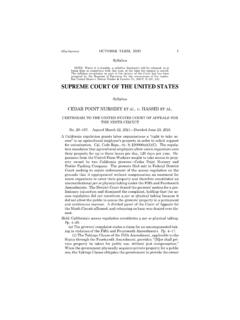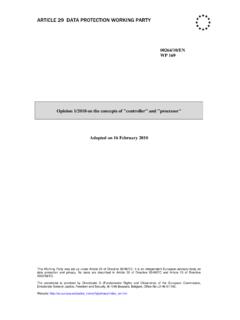Transcription of ARTICLE 29 DATA PROTECTION WORKING PARTY
1 ARTICLE 29 DATA PROTECTION WORKING PARTY This WORKING PARTY was set up under ARTICLE 29 of Directive 95/46/EC. It is an independent European advisory body on data PROTECTION and privacy. Its tasks are described in ARTICLE 30 of Directive 95/46/EC and ARTICLE 15 of Directive 2002/58/EC. The secretariat is provided by Directorate C (Fundamental Rights and Union Citizenship) of the European Commission, Directorate General Justice, B-1049 Brussels, Belgium, Office No MO-59 02/013. Website: 1 00569/13/EN WP 203 opinion 03/2013 on purpose limitation Adopted on 2 April 2013 2 Table of contents Executive Summary.
2 3 I. Introduction .. 4 II. General observations and policy issues .. 6 Brief history .. 6 Role of concept .. 11 First building block: purpose specification .. 11 Second building block: compatible use .. 12 Related concepts .. 13 Context and strategic consequences .. 14 III. Analysis of provisions .. 15 Specified, explicit and legitimate purposes .. 15 Purposes must be specified .. 15 Purposes must be explicit .. 17 Purposes must be legitimate .. 19 Assessment of compatibility .. 20 General framework for compatibility assessment .. 21 Key factors to be considered during the compatibility assessment.
3 23 Further processing for historical, statistical or scientific purposes .. 28 ARTICLE 13 of the e-Privacy Directive on unsolicited communications .. 34 Big data and open data .. 35 Consequences of incompatibility .. 36 Exceptions under ARTICLE 13 of the Directive .. 37 IV. Conclusions .. 38 Analysis of the current legal framework .. 38 Recommendations for the future .. 41 Annex 1: Proposed amendments .. 43 Annex 2: Big data and open data .. 45 Big data .. 45 Open data .. 48 Annex 3: Practical examples to illustrate purpose specification .. 51 Annex 4: Practical examples to illustrate the compatibility assessment.
4 56 3 Executive Summary This opinion analyses the principle of purpose limitation. It provides guidance for the principle's practical application under the current legal framework, and formulates policy recommendations for the future. Purpose limitation protects data subjects by setting limits on how data controllers are able to use their data while also offering some degree of flexibility for data controllers. The concept of purpose limitation has two main building blocks: personal data must be collected for 'specified, explicit and legitimate' purposes (purpose specification) and not be 'further processed in a way incompatible' with those purposes (compatible use).
5 Further processing for a different purpose does not necessarily mean that it is incompatible: compatibility needs to be assessed on a case-by-case basis. A substantive compatibility assessment requires an assessment of all relevant circumstances. In particular, account should be taken of the following key factors: - the relationship between the purposes for which the personal data have been collected and the purposes of further processing; - the context in which the personal data have been collected and the reasonable expectations of the data subjects as to their further use; - the nature of the personal data and the impact of the further processing on the data subjects; - the safeguards adopted by the controller to ensure fair processing and to prevent any undue impact on the data subjects.
6 Processing of personal data in a way incompatible with the purposes specified at collection is against the law and therefore prohibited. The data controller cannot legitimise incompatible processing by simply relying on a new legal ground in ARTICLE 7. The purpose limitation principle can only be restricted subject to the conditions set forth in ARTICLE 13 of the Directive. This analysis also has consequences for the future. ARTICLE 6(4) of the proposed Data PROTECTION Regulation provides a broad exception from the requirement of compatibility, which would severely restrict its applicability and risk eroding this key principle.
7 The WP29 therefore recommends that the proposed paragraph 4 should be deleted. Further, to provide more legal certainty, the WP29 recommends that legislators adopt the above list of relevant factors in order to assess compatibility. Although this presentation of key factors is not fully exhaustive, it attempts to highlight the most typical factors that may be considered in a balanced approach: neither too general so as to be meaningless, nor too specific so as to be overly rigid. 4 THE WORKING PARTY ON THE PROTECTION OF INDIVIDUALS WITH REGARD TO THE PROCESSING OF PERSONAL DATA set up by Directive 95/46/EC of the European Parliament and of the Council of 24 October 1995, having regard to Articles 29 and 30 paragraphs 1(a) and 3 of that Directive, having regard to its Rules of Procedure, HAS ADOPTED THE PRESENT opinion : I.
8 Introduction The principle of 'purpose limitation' ARTICLE 6(1)(b) of Directive 95/46/EC1 (the 'Directive') lists the purpose limitation principle among the key data PROTECTION principles. It provides that personal data must be 'collected for specified, explicit and legitimate purposes and not further processed in a way incompatible with those purposes'. Specification of purpose is an essential first step in applying data PROTECTION laws and designing data PROTECTION safeguards for any processing operation. Indeed, specification of the purpose is a pre-requisite for applying other data quality requirements, including the adequacy, relevance, proportionality and accuracy of the data collected and the requirements regarding the period of data retention.
9 The principle of purpose limitation is designed to establish the boundaries within which personal data collected for a given purpose may be processed and may be put to further use. The principle has two components: - the data controller must only collect data for specified, explicit and legitimate purposes, and - once data are collected, they must not be further processed in a way incompatible with those purposes. When we share personal data with others, we usually have an expectation about the purposes for which the data will be used. There is a value in honouring these expectations and preserving trust and legal certainty, which is why purpose limitation is such an important safeguard, a cornerstone of data PROTECTION .
10 Indeed, the principle of purpose limitation inhibits 'mission creep', which could otherwise give rise to the usage of the available personal data beyond the purposes for which they were initially collected. On the other hand, data that have already been gathered may also be genuinely useful for other purposes, not initially specified. Therefore, there is also a value in allowing, within carefully balanced limits, some degree of additional use. The prohibition of incompatibility in ARTICLE 6(1)(b) does not altogether rule out new, different uses of the data provided that this takes place within the parameters of compatibility.













